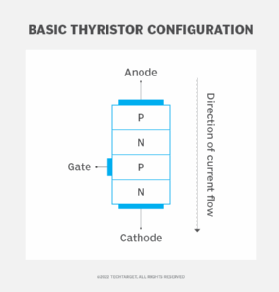What is a thyristor and how does it work?
What is a thyristor?
A thyristor is a four-layer semiconductor device, consisting of alternating P-type and N-type materials (PNPN). A thyristor usually has three electrodes: an anode, a cathode and a gate, also known as a control electrode.
The most common type of thyristor is the silicon-controlled rectifier (SCR). When the cathode is negatively charged relative to the anode, no current flows until a pulse is applied to the gate. Then, the SCR conducts current until the voltage between the cathode and anode is reversed or reduced below a certain threshold or holding value. Using this type of thyristor, large amounts of power can be switched or controlled using a small triggering current or voltage.
Devices using alternating current can be turned on and off by sending a signal to the control gate. This device is called a gate turn-off, or GTO, thyristor. Previously, thyristors needed the current to be reversed to turn off, making them difficult to use with direct current systems.
Thyristors are useful in switching applications because they can be fully on or off. This two-state capability differs from transistors, which operate in between on and off states, waiting for a signal to conduct current.
3 states of thyristors
Thyristors operate in one of the following three states, depending on the requirements:
- Forward conducting This is a thyristor’s primary operating mode. It is switched to conducting mode and stays that way until the current falls below a specific level, called the holding current.
- Forward blocking The thyristor blocks the flow of current, despite voltage being applied in the direction that would signal a diode to conduct it.
- Reverse blocking mode. Current attempts to pass through the thyristor in the opposite direction. However, a diode blocks it, and the thyristor is not activated.

Applications for thyristors
Thyristors support high voltages and possess a simplified approach to switching on and off states. As a result, they are used for the following applications:
- speed controls;
- light dimmers;
- camera flashes; and
- various types of circuits, such as inverter, logic and timer circuits.
A thyristor also can function as a circuit breaker in device power circuits. They prevent power supply disruptions by connecting a Zener diode at the thyristor gate. When power supply voltage levels exceed the Zener voltage, the thyristor turns off the power supply output to the ground and activates circuit breakers or fuses upstream from the power supply. This is called a crowbar effect and protects devices being served by the power supply from damage.

Thyristors vs. transistors
Transistors need an electrical pulse to signal the device to conduct current. Their primary mode is a waiting state in between on and off. Transistors also need their base signal to be continuously refreshed to conduct current.
By contrast, thyristors can be fully off or fully on. Once a signal enters the thyristor gate and activates the device, it remains open until a current reverse occurs or the voltage drops below a specific level.
Learn more about the state of the U.S. semiconductor market.
For all the latest Technology News Click Here
For the latest news and updates, follow us on Google News.
